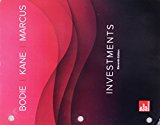
GEN COMBO LOOSELEAF INVESTMENTS; CONNECT ACCESS CARD
11th Edition
ISBN: 9781260201550
Author: Bodie
Publisher: MCG
expand_more
expand_more
format_list_bulleted
Question
Chapter 6, Problem 4CP
Summary Introduction
To determine: It is to be determined that which point represents the greatest level of utility achieved by the investor Introduction: The indifference curve used to represent the difference between the expected return and the risk. It is used for the representation of risk trade of f for the investor
Expert Solution & Answer
Want to see the full answer?
Check out a sample textbook solution
Students have asked these similar questions
Which of the following is considered a long-term financing source for a company?A) Accounts PayableB) Common StockC) Short-term loansD) Accrued Expenses
What is the primary goal of financial management?A) Maximizing profitsB) Maximizing shareholder wealthC) Minimizing costsD) Ensuring liquidityhelp.
If a bond has a coupon rate lower than the market interest rate, the bond will sell at:A) Par valueB) A premiumC) A discountD) Its face valuehelp.
Chapter 6 Solutions
GEN COMBO LOOSELEAF INVESTMENTS; CONNECT ACCESS CARD
Ch. 6.A - Prob. 1PCh. 6.A - Prob. 2PCh. 6 - Prob. 1PSCh. 6 - Prob. 2PSCh. 6 - Prob. 3PSCh. 6 - Prob. 4PSCh. 6 - Prob. 5PSCh. 6 - Prob. 6PSCh. 6 - Prob. 7PSCh. 6 - Prob. 8PS
Ch. 6 - Prob. 9PSCh. 6 - Prob. 10PSCh. 6 - Prob. 11PSCh. 6 - Prob. 12PSCh. 6 - Prob. 13PSCh. 6 - Prob. 14PSCh. 6 - Prob. 15PSCh. 6 - Prob. 16PSCh. 6 - Prob. 17PSCh. 6 - Prob. 18PSCh. 6 - Prob. 19PSCh. 6 - Prob. 20PSCh. 6 - Prob. 21PSCh. 6 - Prob. 22PSCh. 6 - Prob. 23PSCh. 6 - Prob. 24PSCh. 6 - Prob. 25PSCh. 6 - Prob. 26PSCh. 6 - Prob. 27PSCh. 6 - Prob. 28PSCh. 6 - Prob. 29PSCh. 6 - Prob. 1CPCh. 6 - Prob. 2CPCh. 6 - Prob. 3CPCh. 6 - Prob. 4CPCh. 6 - Prob. 5CPCh. 6 - Prob. 6CPCh. 6 - Prob. 7CPCh. 6 - Prob. 8CPCh. 6 - Prob. 9CP
Knowledge Booster
Similar questions
- If a bond has a coupon rate lower than the market interest rate, the bond will sell at:A) Par valueB) A premiumC) A discountD) Its face valuearrow_forwardThe primary objective of financial accounting is to:a) Provide management with detailed reports for decision-making.b) Help the company save taxes.c) Provide financial information to external users.d) Track inventory levels. please help.arrow_forwardWhich of the following is an example of a capital budgeting decision?A) Determining the amount of inventory to keep on handB) Deciding whether to purchase a new piece of machineryC) Setting the credit terms for customersD) Deciding how much cash to keep in the bankarrow_forward
- For pueblo super market in st thomas usviarrow_forwardWhat is the methodology that capital markets serve as engines of economic growth and innovation? Could you help explain how methodology is critical to successful of the capital market? How are they also vulnerable to significant structural and behavioral problems? What are the appropriate uses of a qualitative single case study, and what types of research are best suited for the study of capital markets? What is the research framework of the capital market?arrow_forwardWhat is the purpose of the Capital Markets? What are the qualitative research questions that Capital Markets seek to understand or explain, while quantitative research questions seek to relate or measure? What could be the problems of Capital Markets, and how can the problems of Capital Markets be solved? How can the practice or issue be improved?arrow_forward
- What are the obstacles to work through emotional wellness coping methods, and increasing self-understanding, and how to work through them? What are the advantages and disadvantages of emotional wellness, coping methods, and increasing self-understanding?arrow_forwardWhat is the present value of $10,000 to be received in 5 years, assuming a discount rate of 10%?A) $6,210B) $6,810C) $7,580D) $8,100arrow_forwardDepreciation is:a) The increase in the value of an asset over time.b) The allocation of the cost of a tangible asset over its useful life.c) An amount paid for the maintenance of an asset.d) An asset's market value at the end of the accounting period.arrow_forward
- Depreciation is:a) The increase in the value of an asset over time.b) The allocation of the cost of a tangible asset over its useful life.c) An amount paid for the maintenance of an asset.d) An asset's market value at the end of the accounting period. Need helparrow_forwardWhat is the corporate finance how this is the part of finance?arrow_forwardExplain! Which of the following represents the primary goal of financial management?A) Maximizing net incomeB) Maximizing shareholder wealthC) Minimizing costsD) Maximizing market sharearrow_forward
arrow_back_ios
SEE MORE QUESTIONS
arrow_forward_ios
Recommended textbooks for you
 Financial Reporting, Financial Statement Analysis...FinanceISBN:9781285190907Author:James M. Wahlen, Stephen P. Baginski, Mark BradshawPublisher:Cengage Learning
Financial Reporting, Financial Statement Analysis...FinanceISBN:9781285190907Author:James M. Wahlen, Stephen P. Baginski, Mark BradshawPublisher:Cengage Learning Managerial Accounting: The Cornerstone of Busines...AccountingISBN:9781337115773Author:Maryanne M. Mowen, Don R. Hansen, Dan L. HeitgerPublisher:Cengage Learning
Managerial Accounting: The Cornerstone of Busines...AccountingISBN:9781337115773Author:Maryanne M. Mowen, Don R. Hansen, Dan L. HeitgerPublisher:Cengage Learning


Financial Reporting, Financial Statement Analysis...
Finance
ISBN:9781285190907
Author:James M. Wahlen, Stephen P. Baginski, Mark Bradshaw
Publisher:Cengage Learning

Managerial Accounting: The Cornerstone of Busines...
Accounting
ISBN:9781337115773
Author:Maryanne M. Mowen, Don R. Hansen, Dan L. Heitger
Publisher:Cengage Learning